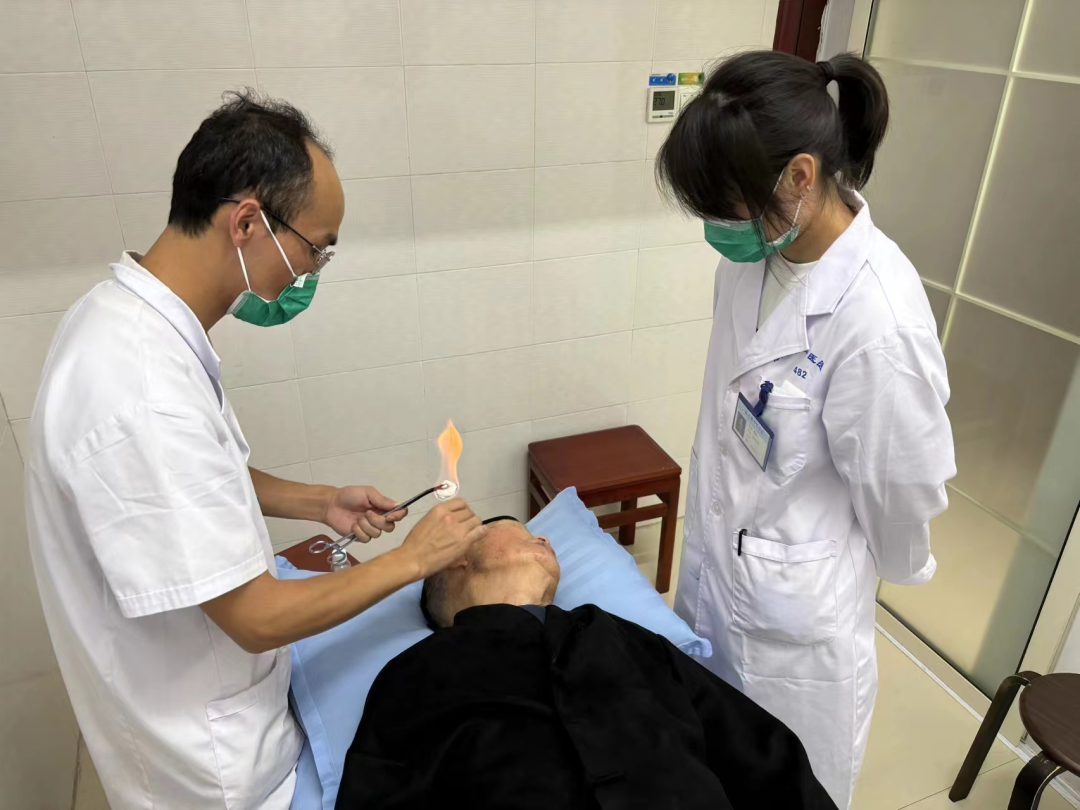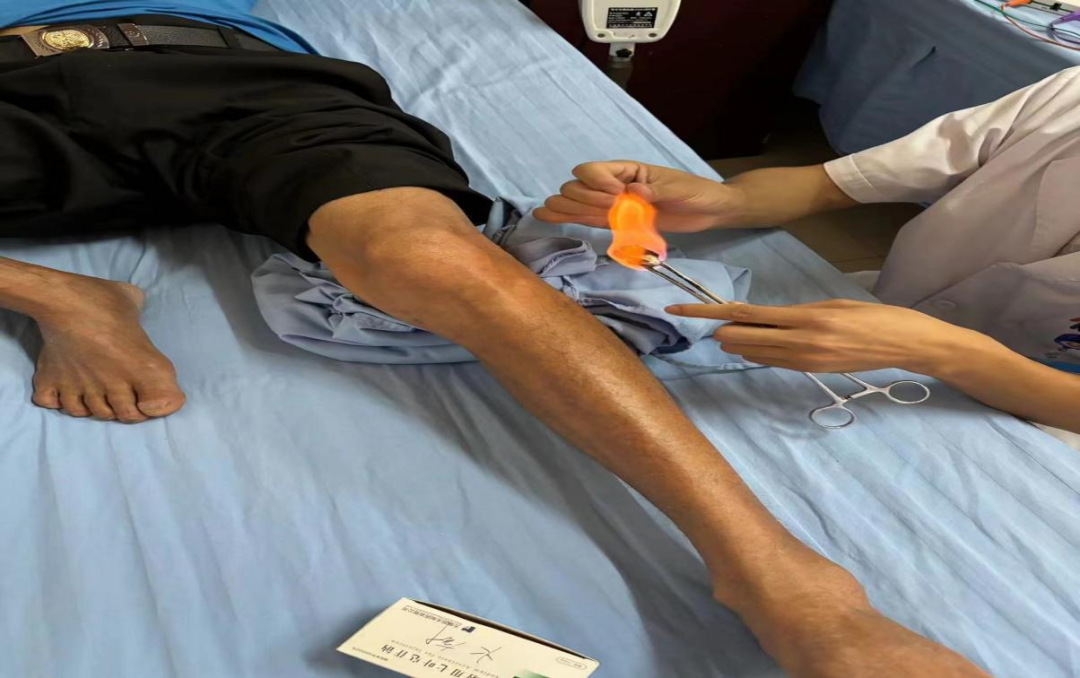Fire Needle
The “Fire Needle Therapy” is referred to as “Burning Needle” (燔针) and “Quenching Needle” (焠刺) in the Huangdi Neijing. As stated in the Ling Shu chapter on meridians: “Treatment involves burning needle quenching,” and in the Ling Shu chapter on acupuncture: “Nine is quenching; quenching means to pierce with a burning needle to relieve obstruction.” The characters “焠” and “燔” both contain the radical for fire, indicating their relation to heat. The character “燔” means to burn or roast, while “焠” is related to “quenching” as in “quenching fire.” Therefore, “quenching needle” refers to a method of quickly inserting a heated needle into the skin. Thus, we can conclude that “burning needle” and “quenching needle” are commonly known today as “fire needle” and “fire needle therapy.”
The greatest feature of fire needle therapy is that it combines the effects of acupuncture and moxibustion. In practice, fire needles require only steady, precise, and quick application, generally without the need for tonifying or reducing techniques, making fire needles simpler and easier to use than regular needles. Due to the significant stimulation from fire needles, they can achieve effects similar to leaving regular needles in place for extended periods without actually leaving them in, and the treatment intervals for fire needles are longer than for regular needles, thus saving patients the trouble of frequent visits, resulting in lower time costs for treatment.
The main drawback of fire needles is the intense pain, which can be intimidating for some patients. However, as long as the practitioner is skilled and the needle type and insertion points are chosen appropriately, the pain from fire needles can be alleviated, and after several treatments, the vast majority of patients can ultimately accept fire needle therapy. Regarding pain, the Ming Dynasty physician Gao Wu compared fire needles with moxibustion: “Moxibustion directly burns the moxa, causing prolonged pain; fire needles, though intimidating to look at, provide quick relief with a single insertion, resulting in less prolonged pain. Thus, it is known that moxibustion can cause prolonged discomfort, while fire needles only cause brief pain.” This comparison refers to traditional direct moxibustion; modern moxibustion often uses indirect methods, which are less effective than traditional methods. In summary, compared to the complexities of acupuncture and moxibustion, the momentary pain of fire needles is bearable.
Using Fire Needles
Since the founding of New China, the government has implemented policies to inherit and develop the heritage of traditional Chinese medicine, providing strong support and protection for acupuncture, allowing it to thrive. However, at that time, the revitalization and development of acupuncture primarily focused on the use of regular needles and various new needle techniques based on them, with insufficient understanding and clinical application of traditional moxibustion, bloodletting, and especially fire needle therapy.

In recent years, due to Professor He Purin being awarded the title of “National Master of Medicine,” his theory of the “Three Passes of Acupuncture” has gained increasing attention, and He’s fire needle therapy has spread rapidly. Looking ahead, fire needle therapy is expected to be included in university textbooks and become a standard treatment method in acupuncture.
“Needle” Meets “Fire” to Unleash Magical Effects
Difficult conditions treated with acupuncture methods: facial muscle spasms, numbness treated at Ashi points with fine fire needles, inserting 1-3 needles at each spasm point; sciatica treated at Kunlun point and Ashi points, with regular needle insertion at Kunlun and 2-5 mm deep insertion at Ashi points with medium fire needles, not leaving needles in; shoulder periarthritis treated at local tender points plus the affected side’s Tiaokou point, tennis elbow treated only at local tender points, both using medium fire needles for rapid insertion; lower limb venous inflammation treated with medium fire needles for surrounding insertion.

Fire needles have a wide range of indications; as the ancients said: “For all cold and heat, deficiency and excess, light and heavy, near and far, it is suitable for all.” This is because fire needles have the following broad effects.
1. Warming Yang and Supporting the Right Qi.Fire needles can use heat to assist Yang, treating various deficiency-cold syndromes caused by Yang deficiency. For example, in cases of middle-jiao deficiency-cold, fire needles can invigorate the spleen and stomach Yang, improving digestive function; for kidney Yang deficiency, fire needles can tonify the kidneys and strengthen Yang, treating kidney deficiency-related low back pain, impotence, and nocturnal emissions; for Yang deficiency with Qi sinking, fire needles can lift Yang to treat conditions like gastroptosis and prolapse of the uterus. When Yang Qi is sufficient, Qi transformation is effective, and the movement of fluids is unobstructed, thus resolving phlegm and edema.
2. Warming and Unblocking Meridians.Meridians are responsible for the circulation of Qi and blood, connecting the body’s interior and exterior, and regulating the functional activities of the organs and tissues.

3. Expelling Pathogens and Dispelling Heat.Fire needles are relatively thick, and with the aid of heat, the needle holes do not close quickly after removal, allowing wind pathogens and some tangible evils to be expelled directly from the body through the needle holes, a method known as “opening the door to drive out pathogens.” For example, in cases of wind-cold invasion, where the lungs fail to disperse and descend, resulting in cough and wheezing, fire needles can use warm stimulation at the acupoints and meridians to warm and disperse wind-cold, driving the pathogens out.
4. Removing Necrotic Tissue and Draining Pus, Promoting Tissue Regeneration and Healing.Removing necrotic tissue and draining pus is a primary application of fire needles in folk medicine, as it is simple and effective, allowing for thorough pus drainage and easy healing of the wound. It is sufficient to insert a heated fire needle into the center of the abscess or at a site conducive to drainage, typically inserting 1-2 needles at the center and 2-3 needles around it.
In addition to the above effects, fire needles also have functions such as resolving masses, lifting Yang, regulating the lungs and relieving wheezing, analgesic effects, relieving itching, eliminating numbness, stopping spasms, and calming wind. In summary, when the body is free of pathogens, fire needles can assist Yang and support the right Qi; when pathogens are present, fire needles can disperse and drive out evils. Therefore, fire needle therapy is a powerful tool for treating difficult and complex diseases in acupuncture.
 END
END Xupu County Traditional Chinese Medicine Hospital
Xupu County Traditional Chinese Medicine Hospital
Author: Jiang Huanan
Editor: Deng Yingjie
First Review: Han Qiuzhen, Zuo Sisi
Second Review: Zhang Lin
Third Review: Dai Jun


